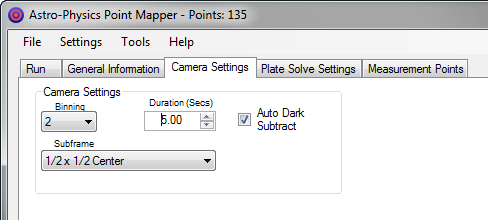Camera Settings Tab

Binning: Select your camera binning here. Camera binning groups pixels together to provide greater signal to noise. 1x1 binning doesn't do any grouping. 2x binning groups four pixels (2x2) into one large pixel. If your image scale when binned in less than 3 arc-seconds/binned pixel then plate solve accuracy will not be affected. For more information on binning see this link: https://www.ccd.com/ccd103.html
Duration: the exposure duration. Typically 5 seconds is enough.
Auto Dark Subtract: when checked, if your camera supports dark frames, APPM will take a dark frame and automatically subtract it from each image before plate solving. This will remove most of the noise from dark current in the images.
Subframe: this selects the fraction of the camera to use. If you have a wide field telescope or a very large sensor you might want to select 1/2x1/2 or 1/4x1/4. This will reduce the download time from the camera and the number of stars in the image. If there are too many stars a plate solve might fail.
Camera Settings Tips
1) Use binning or a 1/2 or 1/4 subframe size to reduce image download time, unless you are using a relatively small sensor.
2) PinPoint's plate solving likes to have around 1-2 arc-sec/pixel resolution so: you can bin 2x or higher with impunity if your image scale is less than 1 arc-second.
3) In star-rich parts of the sky the star catalog may have too many stars for PinPoint to solve. You can reduce the chance of this error by using a a 1/2 or 1/4 subframe.
4) In star-sparse areas of the sky you might need to use full frame images even though image downloads will take longer.
